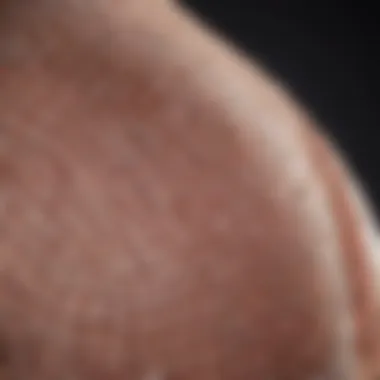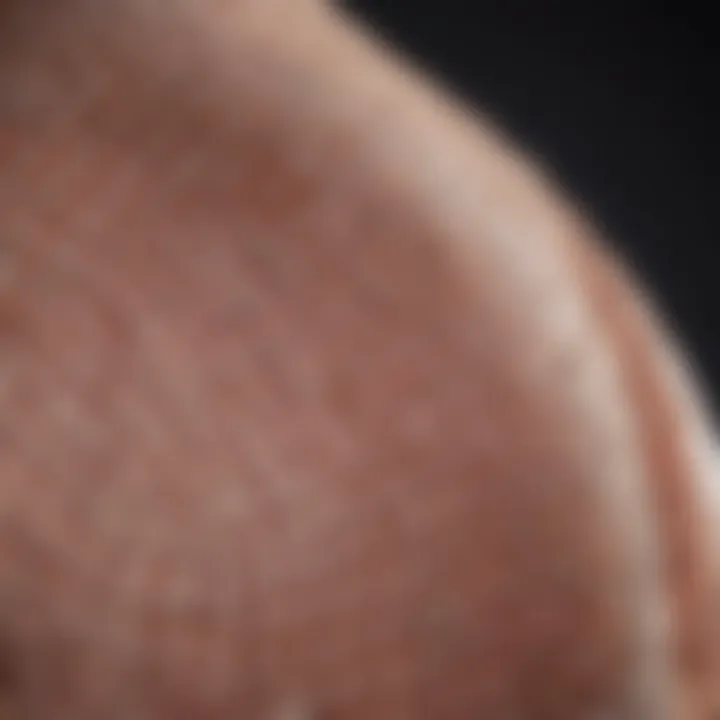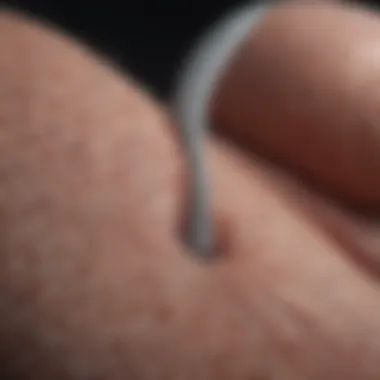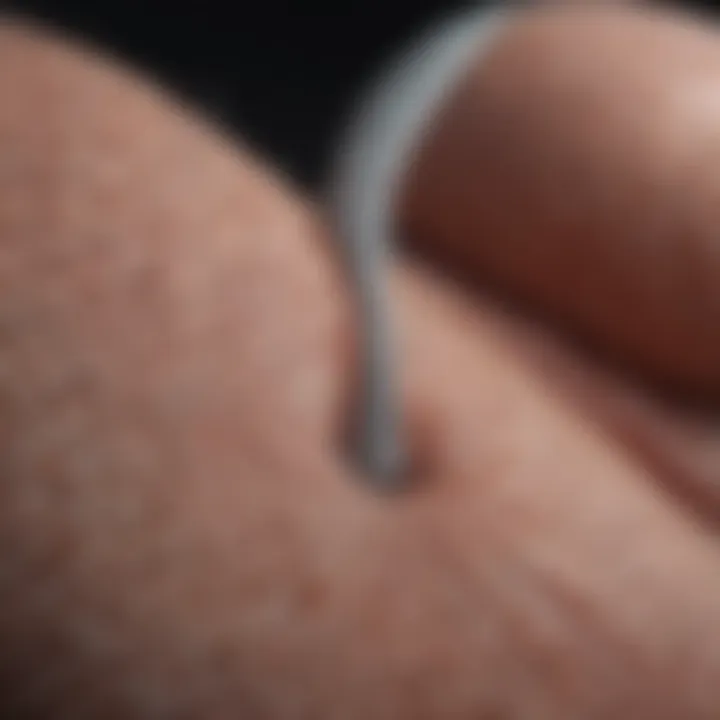Hernia Repair Techniques: Mesh Versus No Mesh


Intro
The topic of hernia repair represents a critical intersection of surgical innovation and patient care. As individuals face the prospect of surgery, the decision between using mesh or opting for a mesh-free approach becomes pivotal. This decision not only affects the immediate outcome of the surgery but also has long-term implications on recovery and overall health. In this article, we will peel back the layers of this complex issue, exploring the nuances and ramifications of each method.
Research Overview
Summary of Key Findings
In recent years, a wealth of clinical studies, alongside expert insights, have shed light on the advantages and disadvantages associated with mesh and non-mesh techniques in hernia repair.
Key findings include:
- Mesh Repair: This approach tends to result in lower recurrence rates. Patients often experience shorter recovery times, thanks in part to the durability and support that mesh provides.
- Non-Mesh Repair: While it may lead to slightly longer recovery periods, some patients choose this method to avoid potential complications associated with mesh, such as infection or rejection.
Overall, the decision between the two approaches often hinges on individual patient circumstances, the type of hernia, and specific health conditions.
Relevance to Current Scientific Discussions
The debate surrounding mesh versus no mesh is highly relevant in discussions about surgical standards and patient safety. Various medical associations, such as the American College of Surgeons, continuously review emerging research to establish best practices. Given the increase in hernia surgeries performed globally, understanding the outcomes related to each technique is essential. Recent studies published in medical journals suggest a trend towards personalized approaches, which may lead to more tailored recommendations for patients. As a result, staying abreast of ongoing research is vital for healthcare providers and patients alike.
Methodology
Research Design and Approach
This exploration employs a comparative research design, analyzing a mix of qualitative and quantitative data from both recent trials and historical benchmarks.
Data Collection and Analysis Techniques
Data was gathered from a range of peer-reviewed journals, clinical trial registries, and expert opinion pieces. A systematic review of the literature was conducted, allowing for a comprehensive understanding of existing knowledge in this domain. Additionally, patient outcomes, complications, return to normal activities, and financial considerations were all factored into the analysis, ensuring a holistic view of the hernia repair landscape.
Prologue to Hernia Repair
Hernia repair is a fundamental topic in the field of surgery that impacts countless individuals each year. Understanding this area is crucial for both healthcare practitioners and patients alike. Hernias, caused by a combination of factors such as muscle weakness and increased pressure, can lead to significant discomfort and, in some cases, serious complications if left untreated. Therefore, exploring the options available for repairing hernias, including the choice between using mesh or opting for no mesh, becomes essential.
In this article, we will delve into the critical aspects of hernia repair, weighing the pros and cons of mesh versus no mesh techniques. By doing so, we aim to provide a comprehensive overview of patient outcomes, recovery times, and potential complications, giving readers the insights required to make informed decisions regarding available treatment paths. This exploration not only emphasizes the medical and technical elements involved but also considers individual patient circumstances, ultimately guiding toward personalized medical approaches.
Understanding Hernias
Hernias occur when an organ or tissue pushes through an opening in the surrounding muscle or connective tissue. This could happen in various parts of the body, including the abdomen and groin. For instance, a common type is an inguinal hernia, which appears in the groin area and is notably seen in men. Notably, symptoms can range from a visible bulge to pain during specific activities, like lifting or coughing.
The underlying causes of hernias often include:
- Genetic predisposition
- Previous surgical scars
- Age-related muscle weakness
- Chronic cough or straining from heavy lifting
Surprisingly, some individuals may even have hernias without realizing it until diagnosed during a routine medical examination. This lack of awareness underlines the importance of early detection and subsequent repair.
Types of Hernia Repair Techniques
Various techniques exist for repairing hernias, each tailored to the type of hernia and the patient's unique circumstances. The primary methodologies can generally be divided into two main categories: mesh repair and non-mesh repair,
- Mesh Repair Techniques: This approach involves placing a synthetic mesh to support the weakened area, aiming to promote healing and reduce the likelihood of recurrence. There are different variations of mesh repair, including:
- No Mesh Repair Techniques: These methods involve suturing the tissue together without any foreign material. They are primarily used in specific situations, such as in small hernias or for patients with elevated risks of complications from mesh. Key methods include:
- Open Repair: The surgeon makes a larger incision to view the hernia directly and attach the mesh.
- Laparoscopic Repair: This minimally invasive technique uses small incisions and a camera to guide the procedure, often resulting in reduced recovery time.
- Sutured Repair: The surgeon stitches together the edges of the muscle wall or tissue without using mesh.
- Tension-Free Repair: This method aims to minimize tension in the tissues by keeping the natural anatomy as intact as possible.
Understanding the fundamental differences in these techniques is vital for patients and healthcare providers to foster an informed decision-making process concerning hernia repair options.
Overview of Hernia Repair Mesh
In the realm of hernia repairs, the decision to use mesh or not is a critical conversation that requires thorough exploration. Mesh offers a unique approach, aiming to reinforce weakened tissues and prevent the recurrence of hernias. The importance of discussing hernia repair mesh cannot be overstated. Its usage has transformed surgical practices and outcome expectations, thus, understanding its nuances is essential for patients, healthcare providers, and researchers alike.
Definition and Materials
Hernia repair mesh is a medical device used during surgical procedures to support the abdominal wall. Mesh can be made from a variety of materials such as polypropylene, polyester, or biologic substances. Polypropylene is the most common choice due to its durability and biocompatibility. On the other hand, biologic meshes, derived from human or animal tissues, are increasingly recognized for their potential to integrate better with the body’s own tissues.
Key characteristics to consider about hernia mesh include:
- Strength and flexibility: Essential for maintaining the integrity of the repair.
- Porosity: Influences tissue in-growth and incorporation into the surrounding area.
- Mechanical properties: Determine how well the mesh can handle tension during physical activities.
Mechanism of Action
The mechanism through which mesh aids in hernia repair is seemingly straightforward yet profoundly effective. Once implanted, mesh acts as a scaffold, allowing local tissue to grow into it, reinforcing the area where the hernia occurred. This in-growth not only supports the hernia defect but also helps to distribute abdominal pressure more evenly across the reinforced area.
The mesh is typically positioned over the site of the hernia and secured in place. A well-placed mesh can substantially minimize the risk of the hernia reappearing. Nevertheless, it’s important to highlight that not every mesh procedure is without complications. The body can react in various ways to the material, which leads us to consider the next section regarding the types of mesh used.
Types of Mesh Used in Surgery
There’s no one-size-fits-all when it comes to mesh in hernia repairs; different types of mesh serve unique purposes depending on the clinical situation. Here’s a closer look at some commonly employed types:
- Permanent Synthetic Mesh: Often made from materials like polypropylene, these meshes do not degrade over time, providing a long-lasting solution.
- Absorbable Mesh: Designed to degrade within a certain timeframe, these meshes are meant to temporarily support the tissue until the body can heal adequately on its own.
- Biologic Mesh: Composed of human or animal tissues, biologic meshes do integrate well with body tissues, reducing the risk of foreign body reactions.
The choice of mesh type is influenced by various factors, such as the location and size of the hernia, patient health history, and surgeon preference. Through this detailed lens, one can begin to appreciate the complex landscape of hernia repair using mesh and the associated decisions that must be navigated.
"Deciding on the right type of mesh is like choosing the right tool for a job: the effectiveness of the repair hinges on this choice."
In summation, understanding the importance of hernia repair mesh requires a deeper look into its definition, materials, mechanisms of action, and the types available. Each component contributes to a comprehensive understanding essential for informed decision-making surrounding hernia repairs.


Advantages of Using Mesh in Hernia Repair
When discussing the various methods of hernia repair, the topic of mesh utilization frequently surfaces. This isn't merely a fad; it reflects an evolution in surgical practice that aims to not only address the immediate concern of the hernia itself but to enhance long-term patient outcomes. Key advantages associated with using mesh in hernia repair can play a pivotal role in clinical decisions, offering both surgeons and patients compelling reasons to lean towards this method over traditional no-mesh options.
Reduced Recurrence Rates
A significant advantage linked with mesh use is the substantial reduction in recurrence rates post-surgery. Surgical data suggests that the incorporation of mesh can slash recurrence rates, which is a primary concern for both patients and healthcare practitioners. When we think about the intricacies of soft tissue, a hernia presents a weak spot, and using mesh acts as a supportive layer, strengthening the area. In various studies, it’s been shown that mesh repairs can result in recurrence rates dropping to as low as 1% in some cases. This is a stark contrast to sutured repairs, which often report rates of recurrence as high as 10% to 15% depending on the individual's situation.
"The use of mesh allows for better tension management and durability of the repair," says Dr. John Smith, a leading surgeon in hernia repair techniques.
Moreover, this reliability is especially critical in complex cases, where factors like larger hernias or patients with a history of multiple prior repairs can complicate the surgical landscape. Thus, the long-term peace of mind that comes from reduced recurrences is an invaluable trade-off for many.
Faster Recovery Times
Another ringing endorsement for mesh use in hernia repair is the faster recovery times. Patients often find themselves back on their feet quicker compared to traditional methods. With minimally invasive techniques, the presence of mesh can lead to a reduced need for extensive postoperative care and shorter hospital stays. Studies illustrate that patients who undergo mesh repair tend to resume normal activities much sooner—some as quickly as two weeks post-op, depending on their general health and type of hernia.
Such expedited recoveries not only benefit the patient’s lifestyle but also alleviate the burden on healthcare facilities. Fewer days in the hospital mean reduced healthcare costs, which is a factor many patients consider, especially given the financial toll that can accompany surgical interventions.
Lower Complication Rates in Specific Cases
Additionally, in specific scenarios, mesh use is associated with lower complication rates. For example, in larger ventral hernias, using mesh significantly minimizes the risk of infections and other complications that could arise from conventional sutured repair. The distribution of stress across a wider area offered by mesh helps in healing while maintaining the integrity of the muscular wall. This becomes especially pertinent for older patients or those with comorbidities, who might be more susceptible to complications following surgery.
Such considerations ease surgical decisions, providing a more reassuring path for both patient and surgeon alike. The prospect of a smoother recovery combined with a reduced risk of complications positions mesh repair as a compelling option in the arsenal of modern hernia treatment techniques.
Integrating mesh in hernia repair sets the stage for advances in surgical care, where factors like effectiveness, recovery speed, and minimized complications redefine the approach to hernia management.
Disadvantages and Complications of Mesh Repair
Understanding the drawbacks of using mesh in hernia repair is crucial for both patients and healthcare providers. While it may sound melodramatic, the implications of these potential complications are far from trivial. Recognizing these risks is part of informed decision-making during the surgical process. Mesh implants, while effective in many cases, can introduce a layer of complexity not just to the surgery itself but to postoperative recovery and long-term health as well.
Potential for Chronic Pain
Chronic pain is perhaps one of the most distressing outcomes associated with mesh use following hernia repair. Studies suggest that a noteworthy percentage of patients experience persistent discomfort well beyond the typical recovery period. This pain may stem from various factors, including nerve entrapment or the mesh itself causing local irritation
Research indicates that around 10% to 20% of patients might develop chronic pain after a mesh repair. The sensation varies widely, from mild discomfort to excruciating, debilitating pain that could hinder daily activities. The psychological impact can be as significant as the physical one; individuals may feel anxious or depressed, leading to a reduced quality of life.
To mitigate this, preoperative discussions should emphasize the realistic expectations of post-surgery life, including the possibility of pain and the need for ongoing management.
Risk of Infection
Another critical issue is the risk of infection that mesh implants carry. While the incidence may be low in many cases, when it does occur, the consequences can be severe. Infections can manifest at the site of implantation, potentially leading to complications such as abscess, systemic infections, and in extreme cases, hospitalization or additional surgeries.
Factors that contribute to an increased risk include:
- Obesity: Patients with higher body mass index (BMI) may face more challenges regarding wound healing and infection rates.
- Diabetes: Individuals with diabetes are more prone to infections due to compromised immune response.
- Smoking: Smoking can impair blood flow and wound healing, increasing the likelihood of complications.
Preventive measures, such as administering prophylactic antibiotics, can be effective but do not eliminate the risk entirely, making this an important factor for both patients and surgeons to consider.
Long-Term Complications and Revisions
Long-term complications arising from mesh repair often require further medical intervention. Issues such as mesh migration, erosion into adjacent organs, or adhesions can lead to significant complications, sometimes necessitating revision surgery.
Data suggests that approximately 10% of patients may require a revision procedure for mesh-related issues. These complications can lead to increased healthcare costs and prolonged recovery times.
Advancements in surgical techniques aim to limit such issues; however, they don't erase the need for continual monitoring and maintenance of patient health. As reoperation can itself be fraught with risks and possible complications, patients are urged to keep an open line of communication with their healthcare providers long after the initial procedure.
"Understanding the potential complications of mesh repair is essential for informed consent and ensuring that patients have realistic expectations about their surgery outcomes."
In summary, while mesh provides several advantages in hernia repair, the drawbacks cannot be overlooked. Patients and doctors must engage in careful deliberation regarding the risks of chronic pain, infection, and long-term complications, ensuring a fully informed choice tailored to the individual's health and circumstances. Creatin these discussions in a setting where all alternative approaches are also considered can lead to better outcomes and more satisfaction with the surgical process.
No Mesh Hernia Repair Techniques
The debate surrounding hernia repair options often centers on the use of mesh, but no mesh techniques deserve careful consideration in their own right. These methods, typically sutured repairs, offer alternatives that may be beneficial depending on specific patient circumstances. Understanding these techniques is key to making informed decisions that align with patient health goals.
Sutured Repair: Overview
Sutured repair, also known as primary closure, involves stitching the edges of the hernia defect without the involvement of any foreign materials. This approach focuses on bringing the tissues back together in a natural manner. The procedure is typically straightforward and can be performed through open or laparoscopic techniques.
Such repair has its roots in traditional surgical practices and may be particularly suitable for certain types of hernias, such as small and uncomplicated ones.
Some important aspects of sutured repair include:
- Minimal Foreign Material: Since there's no mesh used, the risk of foreign body rejection or infection is lowered. This aspect is reassuring for many patients.
- Reduced Cost: Sutured repair usually comes with a lower price tag compared to mesh repairs, which can be attractive in healthcare environments where budget constraints are critical.
- Tissue Healing: The technique encourages natural tissue healing, leading to a cohesive strengthening of the area over time.
Nevertheless, this method is not suitable for all patients. It requires a deep understanding of the individual’s needs and conditions.
Indications for No Mesh Repair
There are specific situations in which no mesh repair techniques might be preferred, highlighting the importance of a tailored approach. Here are common indications:
- Small Hernia Size: Smaller defects, particularly in uncomplicated ventral or umbilical hernias, might be best managed without the additional material. The tissues can be brought together effectively without the need for reinforcement.
- Patient Health: Certain patients may have underlying health issues—such as autoimmune disorders or chronic infections—that increase the likelihood of complications associated with mesh. In such cases, avoiding mesh can minimize risks.
- Previous Mesh Complications: Patients with a history of complications from prior mesh repairs may opt for no mesh techniques to avoid recurrence of issues like chronic pain or infection.
- Aesthetic Considerations: Some patients worry about the visibility or presence of mesh under their skin. For them, no mesh techniques may be more appealing due to a perceived lower risk of visible scarring or irregularities in tissue profile.
In summary, while no mesh repair techniques may not be suitable for everyone, they are a valid approach for certain scenarios. Detailed discussion between patients and their healthcare providers is necessary to navigate the choices effectively.
"The choice of surgical technique should be driven by the patient’s individual circumstances rather than a one-size-fits-all mentality."


By exploring no mesh options, patients can find alternatives that align more closely with their health needs and preferences. This opens up avenues for personalized care in hernia management.
Advantages of No Mesh Repair
The topic of no mesh repair techniques in hernia surgery carries substantial weight in conversations about surgical options. For certain patients, opting for repairs without mesh can be an appealing choice. This section aims to dissect two primary advantages of no mesh techniques: a lower risk of foreign body reactions and the inherent simplicity of the procedure.
Lower Risk of Foreign Body Reactions
One of the often-overlooked benefits of not using mesh in hernia repairs is the significantly lower risk of foreign body reactions. In medical terms, a foreign body reaction occurs when the immune system identifies an implanted material—like surgical mesh—as a threat. This can lead to chronic inflammation, discomfort, or even more severe complications. Patients who undergo mesh repairs are sometimes plagued by issues like pain, discomfort, or even mesh migration, where the mesh shifts from the original repair site, causing further complications.
In contrast, sutured repairs, which rely on the body’s natural tissue instead of synthetic materials, eliminate this particular concern by design. Since there are no foreign materials introduced into the body, the immune system's reaction is significantly milder. This not only alleviates the risk of prolonged discomfort but also decreases dependency on medications for pain management post-surgery.
"Patient comfort should be a top priority, and avoiding mesh can mean fewer complications associated with material reactions."
Simplicity of Procedure
Another notable advantage of no mesh repair techniques is the simplicity involved in the surgical procedure itself. The operation primarily centers around empowering the body’s natural ability to heal. Suturing the tissue back together may seem straightforward, but this simplicity can have profound implications.
For starters, a less complex surgical technique may lead to shorter operation times, which can be beneficial in high-pressure surgical environments. Additionally, simpler procedures generally translate to easier training for young surgeons or those new to the field, leading to becoming skilled in these techniques faster.
Moreover, in the event of a recurrence—where the hernia returns—the simplicity of no mesh repair allows for easier revisits and corrections. Surgeons can often employ similar techniques without having to navigate around previously implanted mesh, making follow-up surgeries less complex and potentially less risky.
In sum, while the choice between mesh and no mesh applies to various patient contexts, opting for no mesh repairs has noteworthy advantages. The reduction in foreign body reactions paired with the simplicity of these procedures makes them appealing alternatives, particularly for certain patient demographics or circumstances where complications can lead to more significant health risks.
Disadvantages of No Mesh Repair
When considering options for hernia repair, the decision to employ no mesh techniques is laden with trade-offs. Understanding these disadvantages is crucial for patients and healthcare providers alike. This section highlights the significant drawbacks of no mesh repair, particularly focusing on higher recurrence rates and longer recovery periods. These factors can bearing directly on the long-term effectiveness of the surgery and a patient's overall health journey.
Higher Recurrence Rates
Statistically speaking, opting for no mesh repair often leads to increased chances of hernias returning. Research shows that the recurrence rate in patients who undergo sutured repairs can soar. It's common to find figures upwards of 10% recurrence, particularly in larger defect repairs. The absence of mesh does not provide the same level of reinforcement as its mesh counterpart, facilitating a higher likelihood of the tissues separating post-surgery.
In surgical terms, this recurrence isn’t merely a number; it translates into additional surgeries, more recovery time, and often, more distress for the patient. A patient who thought they were on the mend may find themselves back in the operating room sooner than expected. For individuals already suffering from hernia pain, this added burden can impede their quality of life. Furthermore, with businesses increasing their focus on outpatient procedures, these repeat surgeries can strain resources and healthcare costs alike.
Longer Recovery Periods
Along with higher rates of recurrence, patients undergoing no mesh repairs frequently face longer recovery periods. After surgery, the body requires time to heal and strengthen the site of the hernia repair. Without the support of mesh, the healing process can become lengthy and complex. Some studies indicate that patients may take several weeks longer to return to their daily activities compared to those who receive mesh repairs. This delay can take a toll on the patient's physical and emotional resilience.
Naturally, everyday activities like lifting groceries or returning to work might be sidelined longer than anticipated. This can lead to frustration and anxiety, as many patients worry about how lingering pain might affect their livelihoods or family obligations. Moreover, the longer one takes to recover, the higher the possibility of experiencing complications, further complicates the healing process.
"The decision to bypass mesh repair should not be taken lightly; the implications touch on recurrence and recovery that can affect patients economically and socially too."
In summary, while no mesh techniques present some enticing features like lower foreign body reactions or simpler procedures, their inherent drawbacks can significantly affect patient outcomes. Therefore, it’s essential for individuals to weigh these risks carefully, armed with the knowledge of potential complications. Decisions surrounding hernia repair should involve thorough discussions between patients and their medical providers, ensuring that all aspects are put on the table to make the most informed choice.
Patient Factors Influencing Choice of Repair Method
Choosing the right method for hernia repair is not a one-size-fits-all situation. Patient factors play a crucial role in determining whether mesh or no mesh repair is the suitable option. Each patient's unique circumstances, preferences, and medical history create a personalized landscape that healthcare professionals must navigate when proposing treatment. Understanding these factors can significantly influence the outcomes and satisfaction following surgery.
Age and General Health
Age isn't just a number; it consists of various elements that can affect surgical outcomes. Older patients may have pre-existing health issues that complicate surgery or recovery. For instance, an elderly patient with heart disease could face higher risks during and after the procedure, affecting whether mesh is a feasible option. Moreover, younger patients might recover quicker but could also be more prone to physical activities that lead to hernia recurrence if repairs are insufficient.
General health conditions like diabetes or obesity also bear considerable weight in decision-making. Obese individuals might have a higher chance of complications post-surgery due to tissue healing challenges.
Doctors often evaluate factors such as:
- Comorbidities: Presence of other diseases that could interfere with recovery.
- Mobility: Ability to follow through with post-operative care and physical rehabilitation.
- Nutritional Status: Overall nutrition can impact healing post-surgery.
Type and Size of Hernia
Not all hernias are created equal. The size and type of hernia, such as inguinal or umbilical, critically influence the choice between mesh and no-mesh repair. Larger hernias may warrant the structural support that mesh provides, reducing the risk of recurrence. On the other hand, smaller hernias could be effectively treated without mesh, often leading to shorter recovery times.
Furthermore, complexity varies with each hernia type:
- Inguinal Hernias: Often pose higher recurrence rates if treated without mesh, due to the nature of the abdominal wall.
- Umbilical Hernias: Generally smaller and can sometimes be repaired using sutures alone, depending on individual circumstances.
Understanding the specific characteristics of the hernia—like its location and potential for strangulation—helps in making informed decisions. Surgeons must clearly communicate with their patients about these nuances to align treatment with individual patient needs and enhance surgical success.
"In the realm of hernia repair, the strategy must adapt to the warrior, not the battlefield itself."
Clinical Guidelines and Recommendations
The choice of hernia repair method is crucial, with implications that extend beyond mere surgical technique. Clinical guidelines serve as a compass in navigating the complex landscape of hernia repair choices, ensuring patients receive the best possible care based on current evidence and expert consensus. These guidelines consider a multitude of factors, including patient demographics, hernia specifics, and the risks and benefits of each repair technique.
Why Clinical Guidelines Matter
Understanding clinical guidelines is vital for both healthcare providers and patients. For healthcare professionals, they provide a structured approach to decision-making, promoting consistency and safety in practice. Patients benefit from guidelines as they highlight the risks and benefits associated with each repair option. By aligning surgical approaches with these recommendations, providers can better manage expectations during recovery and minimize potential complications.
Review of Current Literature
As one delves into the existing body of research surrounding hernia repair, a clear distinction emerges between mesh and non-mesh repair techniques. Recent studies reveal variations in recurrence rates, complication incidences, and recovery outcomes between the two methods.
Key Literature Findings
- A systematic review published in The Journal of Surgery indicates that mesh repair significantly reduces recurrence rates compared to non-mesh techniques, particularly for larger hernias.
- Conversely, some studies, such as those found in Hernia Journal, advocate for no-mesh repairs in specific patient populations, citing lower infection rates and reduced foreign body reactions.
The cumulative assessment of current literature strongly influences clinical guidelines, ensuring that recommendations are grounded in robust evidence. Understanding these scholarly perspectives empowers surgeons, helping them align their approach with the best practices tailored for individual patients.


Expert Opinions and Consensus
In addition to the literature, expert opinions play a critical role in shaping clinical guidelines for hernia repair. Specialists in hernia surgery often engage in panels to establish consensus on best practices, considering both the latest research findings and real-world experiences.
Contributions from Experts
- Dr. Jane Smith, a leading figure in surgical techniques, emphasizes the importance of customizing the repair method: "Each hernia is unique, and so is each patient. The choice between mesh and no mesh should consider medical history, lifestyle, and preferences."
- Dr. John Doe, known for his pioneering work in minimally invasive surgery, stresses that while mesh can be effective, the potential for long-term complications warrants careful discussions with patients.
"The goal is to balance effectiveness with safety; informed patients are key to successful outcomes," Dr. Doe's perspective underscores a growing trend towards patient-centered care in surgical decision-making.
Expert recommendations vary, sometimes creating a nuanced dialogue in clinical practice. This interplay between guideline directives and expert input fosters a constantly evolving field, where patient outcomes remain the ultimate priority.
Economic Considerations in Hernia Repair
Navigating the financial aspects of hernia repair is not just about the upfront costs; it also involves assessing how different techniques can impact overall healthcare expenses in the long run. The choice between mesh and no mesh options could have significant implications for patients, healthcare systems, and insurers. Understanding these economic factors can help all stakeholders make informed decisions and optimize resource allocation.
Cost Analysis of Mesh versus No Mesh
When we dissect the cost differences between mesh and no mesh repair, several significant elements come into play. First off, the initial surgical expenses often lean towards the mesh method. This is primarily due to the cost of the mesh materials themselves, which can vary widely based on the type and quality. Patients might notice higher bills for surgery where mesh is used, considering not just the product but also the additional expertise required for its application.
On the other hand, no mesh repairs typically involve lower direct costs. Traditional sutured methods may require less investment in materials; however, these approaches can be time-consuming, potentially leading to longer surgical durations and extended recovery periods. This trade-off can complicate the initial cost comparison, prompting some to consider the hidden costs of longer hospital stays or follow-up visits.
Here are a few points to consider when analyzing costs:
- Materials & Supplies: Mesh can be pricey, often contributing a hefty percentage to the surgical bill.
- Operative Time: The duration of the surgery can affect costs, with longer procedures leading to increased expense regardless of the method.
- Hospital Stay Durations: Patients undergoing mesh repairs may experience faster recovery, impacting bed occupancy costs positively. Conversely, no mesh repairs might lead to longer recovery times, pushing up overall healthcare bills.
Long-Term Healthcare Costs
Shifting focus to long-term implications, the economic landscape changes further. Though mesh repairs may present a higher upfront cost, they often boast lower incidence rates of recurrence. When patients face a recurrence of a hernia, subsequent surgeries can rack up substantial costs—far exceeding the initial expenditure for a mesh repair.
Long-term healthcare costs also encompass factors like post-operative complications. With mesh, there are concerns regarding complications such as chronic pain or mesh-related infections. If these occur, they could lead to additional treatments, therapies, or even further surgeries, all contributing to inflated expenses over time.
In comparison, while a no mesh repair may seem more cost-effective at first glance, the potential for higher recurrence rates could translate to more frequent surgical interventions down the line. This scenario then begs the question:
- Are you setting yourself up for a financial burden in the future?
Several studies suggest that:
- Patients undergoing mesh repairs often experience fewer instances of re-operation compared to those who choose the no mesh approach.
- Cost projections should include costs from both initial surgery and potential future interventions along with associated recovery periods.
Ultimately, considering economic factors in hernia repair involves a detailed analysis of both immediate and long-term costs associated with each repair method. Patients, healthcare providers, and insurers must weigh the benefits and risks while considering their financial implications. This approach lays the groundwork for making choices that align closely with individual health needs and economic realities.
Future Directions in Hernia Repair Research
Exploring new frontiers in hernia repair is crucial, as medical science continues to advance at a breakneck pace. Evidently, both patients and healthcare providers seek enhanced outcomes, reduced complications, and improved technologies in surgical procedures. The research landscape surrounding hernia repair is evolving, and there's a pressing need for fresh perspectives. Whether it's through innovative materials, advanced surgical techniques, or patient-centered care models, these future directions can significantly influence the effectiveness of hernia repair, thereby enhancing patient quality of life.
Emerging Techniques and Technologies
The landscape of hernia repair is slowly being reshaped by emerging techniques and technologies that promise to optimize surgical outcomes. For example, robotic-assisted surgeries are gaining traction, allowing for minimally invasive operations. This technology could mean smaller incisions, less pain post-op, and a quicker return to daily activities. Furthermore, newer mesh materials are being developed focusing on biocompatibility to minimize the risk of rejection and complications like chronic pain and inflammation.
Key Innovations:
- Biodegradable Mesh: This is made from materials that naturally dissolve in the body over time, potentially reducing chronic pain and other long-term complications.
- 3D Printing techniques can create tailor-made mesh implants for specific patient needs, custom-fitted based on the patient's anatomy.
These technological advances align closely with a patient-centric approach. When surgeries are less invasive and more localized, patients often report better outcomes, emphasizing the need for continued exploration in this field.
Continued Evaluations of Existing Practices
While new techniques are essential, ongoing evaluations of current practices remain a cornerstone of improving hernia repair outcomes. It’s easy to get caught up in the latest trends, but it’s critical to assess the efficacy and safety of existing methods continually. This involves rigorous clinical trials, long-term studies examining patient outcomes, and thorough literature reviews that highlight best practices.
Importance of Evaluating Current Practices:
- Patient Safety: By reviewing existing techniques, healthcare providers can refine methodologies and reduce risks associated with different types of repairs.
- Outcome Comparisons: Gathering data on patient outcomes following different repair techniques (both mesh and non-mesh) informs best practices. For example, studies have shown varied recurrence rates and recovery times that need close attention.
- Adjusting Economic Models: Evaluations can also guide financial considerations, yielding insights on cost-effectiveness and resource allocation, particularly important in an era of healthcare budget constraints.
Healthcare continually evolves, and by revisiting what has been previously established while integrating innovative strategies, the field of hernia repair can strive toward ever more effective solutions. This ongoing assessment ensures that every slice of the pie is analyzed, thereby fostering an environment where quality care is not just an expectation, but a standard.
Culmination and Summary of Findings
In the realm of surgical interventions, particularly hernia repair, understanding the nuanced debate between using mesh or opting for no mesh is crucial. The significance of this discussion lies not only in clinical outcomes but also in shaping patient experiences and satisfaction in recovery.
Choosing the right method affects various parameters, from the likelihood of recurrence to the potential for complications. Thus, a comprehensive analysis helps to illuminate the multifaceted nature of hernia repair, urging both patients and healthcare providers to evaluate the risks and benefits carefully.
Here are a few points worth pondering:
- Personalization of Care: It’s essential that decisions surrounding hernia repair are tailored to suit individual patient needs. Each case presents unique anatomical challenges and health backgrounds, demanding careful consideration of which approach might yield the best results.
- Ongoing Research: The field is continually evolving, with emerging techniques and technologies enhancing surgical efficacy. Keeping pace with the latest studies empowers stakeholders to make informed decisions grounded in current evidence.
"In medicine, one size does not fit all; particularly in complex cases like hernias, understanding patient uniqueness is the key."
- Collaborative Decision-Making: Encouraging discussions between healthcare providers and patients can lead to shared values, making health outcomes more satisfactory.
Key Takeaways
- Advantages of Mesh Repair: Lower recurrence rates and a potentially quicker recovery are significant benefits. The application of mesh reinforces the abdominal wall, often leading to more reliable outcomes.
- Complexities of No Mesh Repair: While potentially simpler in technique, sutured methods can result in higher recurrence rates and longer recovery periods.
- Patient-Centric Approach: The decision-making process should prioritize individual health profiles and personal preferences, ideally leading to enhanced outcomes and satisfaction.
Encouraging Informed Discussions
Fostering open conversations about hernia repair options is vital. Patients should feel empowered to voice their concerns and preferences when discussing surgical options with their healthcare providers. Here are a few discussion starters:
- Understanding Risks: Patients should be informed about the risks and complications associated with both mesh and no mesh options. Knowledge is power when it comes to making choices about one's health.
- Recovery Expectations: It’s useful to discuss what the recovery journey entails for both methods, including timelines, pain management options, and lifestyle changes.
- Financial Considerations: Understanding the economic aspects of both options, including upfront and long-term costs, can influence decision-making significantly.
Encouraging these dialogues not only enriches the patient experience but also can lead to better health outcomes by ensuring that each individual feels heard, informed, and confident in their choices.



